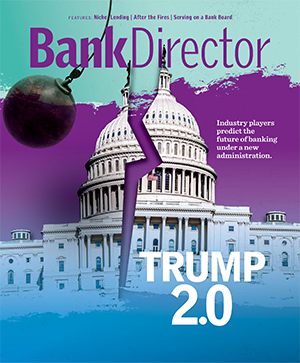In 1972, a can of Coke cost 10 cents, bacon was 79 cents per pound and the majority of payments were made by cash or check. That same year, a group of California bankers created the first automated clearing house (ACH) association and instituted electronic payments. Other regional associations soon appeared, and two years later Nacha was formed to administer the ACH network. It didn’t happen overnight, but today ACH is ubiquitous, processing 31.5 billion transactions worth $80.1 trillion in 2023.
In 2017, The Clearing House Payments Co. launched the first instant payments system, Real Time Payments (RTP), which was the first new payment rail in the United States in over 40 years. Last year, the Federal Reserve launched its own instant payments network, FedNow. Currently, most financial institutions (FIs) are participating in instant payments as receive-only. Until more get on board with sending, the true value of the instant payment ecosystem can’t be fully realized.
Just as ACH did all those years ago, RTP and FedNow are transforming payments in the commercial space by increasing transparency and speed while reducing costs. With the traditional system, business A performs a service for business B and sends them an invoice. Business B then initiates payment via ACH, wire or check. Communication about the payment, including invoicing, remittance, reconciliation and receipt confirmation are often handled manually through mail, email or phone. Roughly 78% of payments made using ACH have the remittance information sent via mail or email.
Instant payments allows business A to initiate the process by sending business B a request for payment (RFP) that includes invoice details or an image of the invoice. Business B can request more information, pay the invoice immediately or schedule payment in advance, precisely to the minute. This is a huge advantage for businesses that allows them to maximize their cash investments. So, if a payment is due at midnight, the payer can schedule it for 11:59 p.m., and the transaction is complete in seconds. The beauty of instant payments is that the information about the payment travels with the payment throughout the entire process.
Three Key Questions About Instant Payments
1. Will instant payments open my financial institution up to more fraud, and how do I mitigate that risk?
Both RTP and FedNow are push networks, meaning that the payer can send payments, but the payee can’t pull them, making it safer than some traditional payments. Banks already have safeguards to help mitigate fraudulent check, ACH and wire payments before they go through. The higher risk is scams and dupes; institutions can mitigate that risk by adding friction before the payment proceeds, similar to what they do with business email compromise situations.
2. My bank doesn’t serve a lot of big corporations. Do we need instant payments?
Some of the biggest users of instant payments are small and medium-sized businesses (SMBs), whose cash flow concerns are sometimes far greater than those of large corporations. Instant payments allows SMBs to access debit and credit card revenue in real time, so they have more control over their cash flow and can pay bills on their terms. They can pay workers more quickly and efficiently and schedule payments to vendors and refunds to customers to the minute, potentially increasing customer satisfaction and decreasing time and money spent on processing. Instant payments can be greatly beneficial to SMBs both in receiving and making payments.
3. How quickly does my bank need to get on board? This doesn’t seem urgent yet.
Today, the RTP network services more than 700 financial institutions, and FedNow services more than 900. The value of transactions processed via an instant payments rail is forecast to grow by 289% between 2023 and 2030.
For banks that have not started at least receiving instant payments, the time is now.
Customers have grown accustomed to immediacy in their personal transactions — expectations that may carry over to their business transactions.
Banks that are receive-only should look to begin sending sooner rather than later. Consumers and SMBs may come to expect this functionality and could go elsewhere if they can’t obtain this service from their primary financial institution.




